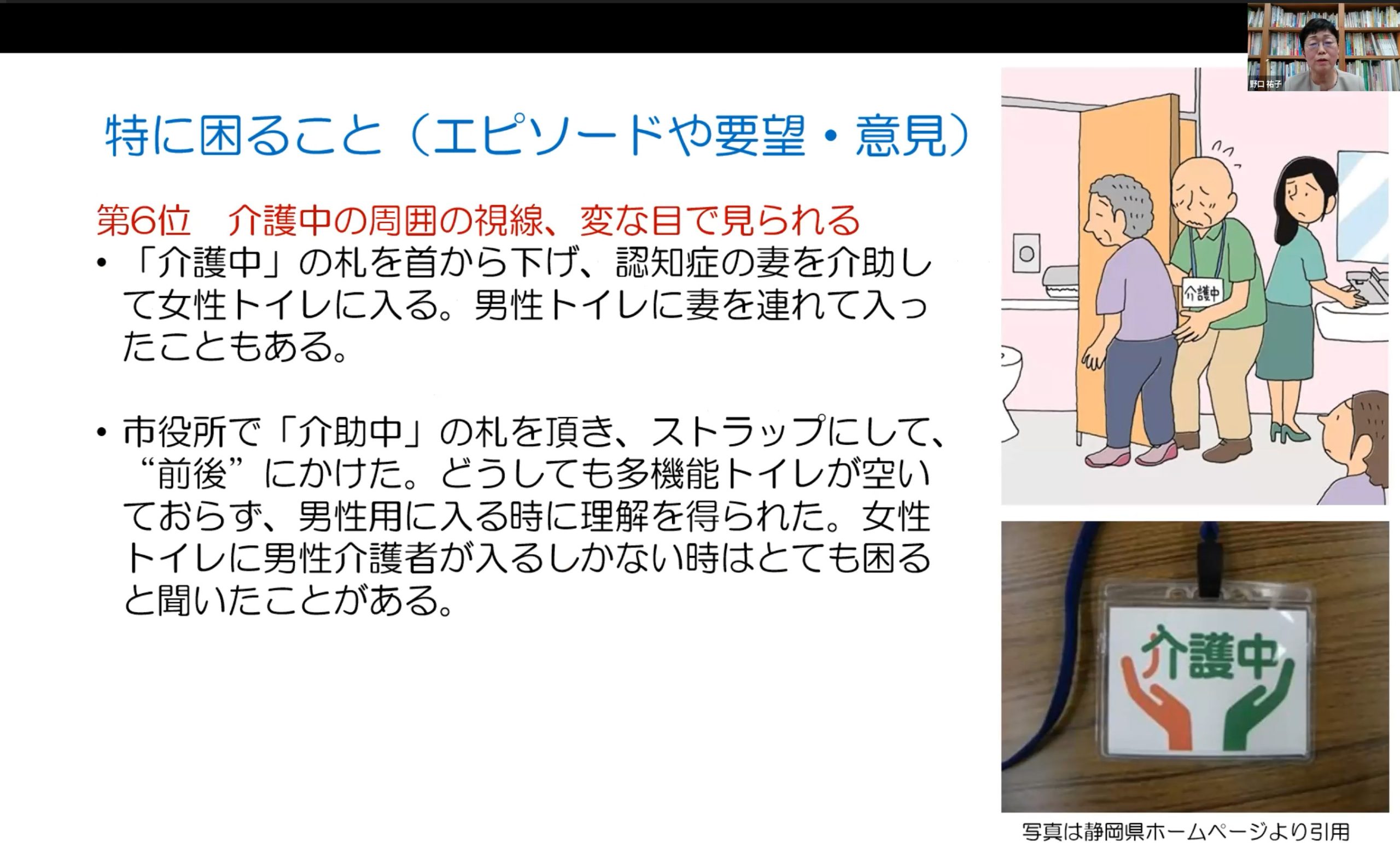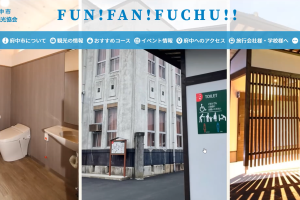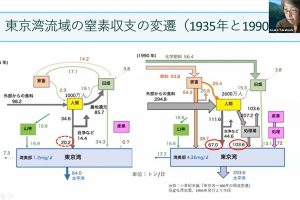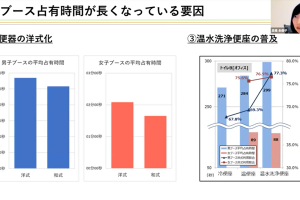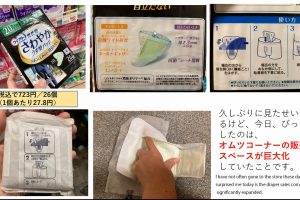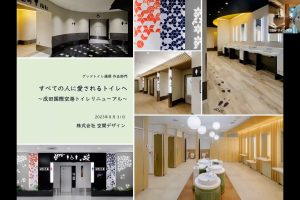The 23th seminar
“What is the toilet comfort ?” -2
– “Evolving Toilets” book series, volume 2 “Comfortable Toilets” edited by Japan Toilet Association
Japan Toilet Association (JTA) Seminar Series; “Let us know more about our Toilet Story”
Date: 20 April 2023 (Thu) 18:00-20:00 JST
Moderator: Junko Kobayashi, Ph.D. (JTA chairperson, Executive Director of Gondola Design Office/ architect)
Presenters:
(1) A toilet that is easy to use even for people with the dementia: A toilet that allows people to go out, Hiroko Noguchi, Ph.D. (JTA member, Professor of Nippon Institute of Technology)
(2) Station toilets: How to create and sustain comfortable toilets, Ms. Yuri Nakagawa (JR East Design Corporation)
(3) Maintenance to keep the toilet comfort, Mr. Nobutaka Yamato (JTA member, Executive Director of Amenity Co., Ltd.)
(Kobayashi)
The previous seminar was Comfortable Toilet Edition of the basics of toilet comfort about facilities, history, and ergonomics. This seminar is of the practical methods of the toilet comfort.
First, Prof. Dr. Yuko Noguchi, at Nippon Institute of Technology, will talk about toilets and the dementia, which is said there are one in five people over the age of 65 in Japan.
In topic 2, Ms. Yuri Nakagawa, general manager of the Engineering Headquarters of JR East Design Corporation, will talk about the toilets of Japan Railways (JR) East, which owns the largest number of toilets of any company in Japan.
In topic 3, Mr. Nobutaka Yamato, Executive Director of Amenity Co., Ltd., will talk about the maintenance methods to keep the toilets comfortable.
(1) “A toilet that is easy for people with the dementia to use – a toilet that allows them to go out from home”
(1-1) Questionnaires on the toilet usage
(Noguchi) Whether a person with the dementia can go out depends on whether there is a toilet that they can easily use. Hospital toilets have a variety of stickers indicating users where to flush the toilet, not to press the emergency call button by mistake, and how to unlock the door. It is ideal that the toilet can be used without these stickers. My mother was diagnosed with Alzheimer disease from 2016. Main problem when going out with my mother was using the toilet. When she went to the toilet in the hospital, she could not come back. About 30 minutes later, I went looking for her and found her getting lost. When I informed her the toilet location, she suddenly enters the men’s toilet section. She could not lock the toilet door because the key type was unfamiliar new type. She couldn’t recognize a door since it was quite thin modern one.
Almost all considerations have mainly focused on the people with physical disabilities until now. However, it turns out that there are some people who can’t use the toilets. I realized that we should consider the needs of a more diverse group of people.
In 2015, the government predicted that one in five elderly people would be dementia by 2025. A caregiver accompanied when a person with the dementia used a public toilet until now. However, I think it will be insufficient and necessary to recognize this as an environmental issue such as equipment. I think the time has come when we cannot proceed with manufacturing or community development and urban planning without taking people with the dementia into account. Japan’s population peaked in 2008 and has been on the decline since then according to the 2022 White Paper on Aging Society in Japan.
On the contrary, the aging rate is increasing and it announced last autumn was 29.1% of the total Japanese population of 120 million. This must increase to 38.4% in 2065. Therefore, we conducted interviews and questionnaire surveys with people with the dementia and their families, and had a verification experiment on the locks and operation buttons in the toilet. The purpose of those researches was to recognize the ease of use of the public toilets by people with the dementia and elucidating the necessary maintenance. We asked in the survey in 2017 about the toilets when going out. They use mostly the hospitals and clinics toilets at 59.1%. Next was commercial facilities such as the department stores and supermarkets toilets at 41.4%. The following ones are restaurants and other eateries toilets at 34.3%.
This shows that it is quite common behaviors for the people with the dementia to go out into the city for shopping and eating. Others accounted for 9.1% were these people who don’t use the toilet when they go out because of the difficulty of the assistance. or they use diapers, or they essentially can’t use the toilet. When asked what kind of underwear they wear when going out, and about 50% of them said they use the pants-type disposable diapers. Additionally, 30% of them said they use the urine absorbing pads, which are often used in conjunction with the diapers. 43.4% of them said that the most common problem of their experiences when going out toilet was finding the toilet.
Next, they feel hard to figure out the flush button or lever. Also, the toilet cubicle is usually small and crowded. They suffered from wetted or stained their clothes. There is no place to throw away pants-type diapers. They happened to urinate before finding the toilet. Some answers were about too far to reach the toilet.
We asked those who answered that they use the commercial facilities when going out, “what are the main problems that they experience?” They answered the first problem was that they got lost after using the toilet, or they separated from the caregiver. The second problem was that the crowded toilets. The third one was to figure out how to operate the buttons or levers for flushing. Fourth one was to find a location of the toilet. The fifth one was to dispose of the pants-type diapers and operate the button to open/close of the automatic door. The sixth one was to feel surrounding people looked at the person strangely while getting provided care. At the first problem that they got lost or separated from the caregiver after finishing the toilet. There was an example that the wife and husband entered separately the men’s and women’s toilets at a shopping centre. The husband with the dementia started walking to find his wife who was late exiting the toilet. After that, her husband was found several hours later after asked the police to search him.
A wife who was caring for her husband wanted to go to the toilet, and they had to look for a toilet which they could use together since she couldn’t leave him alone. There is a high possibility that they may separate from the caregiver and be left alone even at the early stage of the dementia. The caregiver must be able to go to the toilet without worry, if there was a temporary place to look after the person with the dementia.
The second problem was the crowded in the toilet. A wife, who is a caregiver for her husband with the dementia, took long time to use when crowded. Then the husband was quite anxious to stand in the queue among many people.
The third problem of “How to operate the flush the buttons or levers,” some respondents said that they couldn’t figure out how to flush the new featured or stylish ones. They said much simpler and much basic one would be enough to use.
It must be difficult to understand how to use toilet equipment, even those people who are able to move around on their own without the caregiver. There are too many functions and buttons recently and some people get confused and give up going out or holding on water to drink. We will propose that all manufacturers to standardize the shape of the flush buttons to be simple and easy to recognize. They must be ideally the same shape in all manufacturers. Then these people will be saved from locked in the toilet with a few practices.
The fourth problem was a difficulty in finding a toilet location. When there is only one caregiver, it is hard to take an elderly person who cannot walk far to find a public toilet. While the caregiver search toilets with leaving the elderly person alone, the person cannot wait long and bearing risk to go missing. There was a request that there should be a signage that makes it easy to find the location of the public toilet. Some people said that the public toilets were in deep places that were difficult to access, and that the toilet signages were too small which were difficult for elderly people with poor eyesight to recognize them.
The fifth problem is about the issues of the pants-type paper diapers. There was a request that there should be a place to dispose of the diapers not only for the babies but also for the adults. The adult diapers are heavy and smelly after use, making them difficult to bring back to the home. There was also a request that it would be helpful to install a vending machine for the replacement pants-type diapers.
The fifth problem was hard to recognize a button to open and close an automatic door. A sole person in the toilet cubicle with an automatic door couldn’t figure out how to open to exit. What the man did was accidentally to press the emergency call button, then the security guard rushed to rescue.
The sixth problem was about being looked at strangely by those around people while getting provided care. Currently, the Ministry of Health, Labor and Welfare recommends that the caregivers put a tag indicating that they are “A caregiver.” A husband worn this tag around his neck while helping his wife with the dementia, and entering a public toilet of the opposite gender room. There is still feeling difficulty when male caregivers to enter the female toilet space.
(1-2) The verification experiment of the toilet locks and operation buttons
Even people with the dementia shall go out and use public toilets by themselves as usual. Therefore, we conducted experiments with a cubicle in a regular toilet rather than a wheelchair-accessible toilet or a special toilet where a caregiver can enter together. We created a full-size toilet cubicle mockup at a senior citizen facility and 13 participants in their 70’s to 90’s who receive the daycare services tried to open and close the lock and press the button to flush water. We asked them about the cubicle lock usages among three selections: “Hard to use”, “Little difficult to use”, and “No problem to use”. Then all participants answered that they had no problems at all.
Four types of the locks were applied in the experiment: two types were the slide latches, which slides sideways, and the other two types were the rotating locks. There were three types of the flush buttons to let them to try: a large one commonly set in wheelchair-accessible toilets, an eco-remote button created after the catastrophic East Japan Earthquake in 2011 that generates electricity by pressing, and a smaller vertical rectangular button. As a result, all participants used the slide latch within 1 to 2 seconds without any problem. Some people took 6 to 8 seconds to open the rotating lock because they either pressed the round part at the centre of the rotator by misthink to have imagined it was a button, or tried to hold the round part. Regarding the flush button on the toilet bowl, about 80% of people were able to use the largest type without any mistake. About half of the participants using the Eco remote control operated it incorrectly. About 30% of the vertical rectangular buttons were mis-used. Many people accidentally pressed the emergency call button.
After doing these surveys, we proposed that a toilet space must be large enough to accommodate with the caregivers of the opposite gender, and set up benches outside of the toilet and asked the person with the dementia who can wait on the bench when the caregiver needed to use the toilet. We also suggested that when a person with the dementia needs to use the toilet, the door may be left unlocked and the caregiver will wait outside on the bench.
We published a booklet titled “Public Toilet Handbook” (Ref.1) with these suggestions in 2019. We received the “New Wave Award” among the NHK Welfare and Culture Corporation’s City Living with Dementia Award.”
Ref.1; https://www.nit.ac.jp/application/files/4016/2060/4522/toiret_handbook.pdf
New Wave Award in 2019 was conferred to the supermarket “Maiya” in Iwate Prefecture where is promoting a slow shopping. We collaborated and built a toilet in Maiya store for people with the dementia. The toilet was designed by the office Gondola, whose Executive Director is Dr. Kobayashi as well as the chairperson of Japan Toilet Association. It received the “Good Toilet Commendation” award by Japan Toilet Association, which annually awards for the outstanding efforts related to the toilets.
(2) “Railway Station toilets: How to create and keep the comfortable toilets”
(Nakagawa) I mainly talk about toilets in Japan Railways (JR) East stations.
1. How have station toilets been changed?
2. Are the station toilets we currently use comfortable?
3. The station has changed and how about the toilet?
4. What station toilets shall be?
(2-1) How have station toilets been changed?
35 years ago, the station toilets had a quite bad reputation: they were dirty, smelly, dark, broken, scary, and overcrowded. Today, toilets are situated in easy-to-find locations within the stations, but in the past, the station toilets were in hidden and conspicuous places. The monopolized national railway company became privatized to be JR on1 April, 1987. There left toilets at stations in the days of former Japan National Railways, and there was no concept of making them comfortable for the passengers to use. We had to reinvent ourselves at the time when became JR and changed from a nationally owned railway to a private company. We recognized the comfortability of the passengers must be the top priority and kept the toilets clean.
We thought that we needed to make the station cleaner, and we started to improve the toilets, which were the dirtiest parts of the station. At first the staffs of the construction department who oversee about the station design, started cleaning and painting the station toilets by themselves. At that time, the station toilets were in inconspicuous places, and the signages were too small and difficult to find. There was no toilet paper equipped, but there was a vending machine to purchase the tissues or the feminine hygiene products at the entrance of the station toilet. There were commonly several steps to enter to the toilets.
(2-2) Are the station toilets we currently use comfortable?
As we made various attempts, we gradually got funding for the station renovations. It started from the larger stations to clean them up. For example, Shimbashi JR Station spent a lot of money to build clean toilets but required users to pay a tip. We published a booklet called “Station Toilet Design Manual” in 1999 gathering the experiences and the know-hows on how to do it. We still refer to it. It was only 10 pages at the first stage, but now it is over 200 pages.
The Barrier-Free Transportation Act enacted in 2000 and the Barrier-free Act did in 2006. These acts require to install the multifunctional toilets for people with disabilities, and to install the entrance with ramps or flat floor. In addition to cleaning up the toilets, the efforts are underway to make the toilets more visible and easier to find. In the past, there was an only small signage hanging down, but now the entire wall is covered with easy-to-understand toilet signage.
A station of 20 years ago had the stairs to the left after entering the ticket gate that led up to the platform. The toilet was located under the stairs in a dimly lit area that was difficult to find, and there were also steps at the entrance. Now, the location has shifted to the front of the ticket gate. While we build a new toilet in the different location, the passengers can use the old one. Then, it was common for new toilets to be built in completely different locations finally. The place where the current toilet is located was once a convenience store and a noodle restaurant. It was the best location where we could expect a lot of income. The reason why they are switching such a best location to the toilets where cannot generate income is because station toilets are required to follow the barrier-free act.
(2-3) The station has changed and how about the toilet?
About 20 years ago, we started building shops inside stations called “Ekinaka” (cf.1) which means shops and restaurants inside of the station. Before that, all passengers only went through the station to board the train, but after building shops “Ekinaka”, passengers spent more time inside the station. Naturally, this will increase to use the toilet more frequently. In addition to the cleaning toilet, we surveyed to find out how many toilet bowls will be necessary. It is impossible to install enough toilets to avoid queues even during the busiest time at stations. We tried to calculate the ideal number of toilets on the condition besides the peak hours. I am researching on the optimum numbers of toilet bowls and the balance between male and female toilet numbers.
(cf.1) Eki means station and Naka does inside.
(2-4) What station toilets shall be?
“Station Toilet Design Manual” which I introduced before was published in 1999. It is still referred to even this day. It is regularly revised about once every three years depends on the law changes. Soon it will probably be revised, because the government is currently alleging that the multi-functional toilets may be functionally distributed in toilet layouts by each function. Nevertheless, the purpose and basic concept have not changed from the beginning.
<The purpose of the station toilet design manual>
This manual describes the details of improvements to make it easier to use for all passengers, including the elderly and those with disabilities at the station toilets more comfortably. This aims to improve and standardize the level of service to install and improve the station toilets referring to this manual.
<The basic concepts of the station toilet design manual>
・Make station toilets safe and easy to use.
・Clean station toilets.
・Make station toilets bright and comfortable.
The more toilets become cleaner the more passengers will use them. I think the requirements for toilets are shifting since they are now used by a wide variety of people. We believe the purpose and basic concept will not be changed.
(3) “Toilet maintenance to keep it comfortable”
(3-1) Maintaining a comfortable toilet
(Yamato) I am an executive director of Amenity Co., Ltd., which provides services to maintain the comfortable toilets. The company is in Yokohama, and there are about 60 franchise companies in Japan, and two in South Korea. It has an in-house qualification system as “A toilet diagnostician.” It is an in-house test certified by the Ministry of Health, Labour and Welfare. There are 1st and 2nd grade qualifications. You cannot pass when you don’t study properly.
I will talk about the maintenance system and methods to be necessary to keep the comfort of the public restrooms. People normally go to the toilet five to seven times a day. It is said that the average male lifetime is 81 years and he uses the toilets at least147,825 times in his lifetime. On the other hand, the average female lifetime is 87 years and she uses the toilet 158,775 times in her lifetime. In fact, there is no other living space where to tarnish several times every day. People generally think that toilet is a dirty place in the house.
In particular, the public toilets are used by the unspecified people, hence there conceal many problems. It is difficult to keep clean because of the large numbers of users and difficulty to know the user in person. In addition to the dirt, sometimes there are left the pranks and graffiti. Furthermore, there are problems such as homeless people staying there. One public toilet occurred to lost a door lever at the entrance. This can be removed only from the inside with using a special tool. It was lost for three consecutive months even though it was repaired every month. Toilets are sometimes covered with the graffiti, and this tends to exclude people from using the comfortable toilets. The homeless people often stay in public toilets.
There found many clothes, shoes, and towels which were stuffed into the plumbing space behind the bowl. This toilet was newly built, but the cleaning staff said that three homeless people stayed, and they hid their belongings there. No matter how much money we spend to build a luxurious, well-designed toilet, if we don’t maintain it properly, it will quickly become uncomfortable. New toilets deteriorate day by day from the moment they are built. A single person may be able to maintain the toilet comfort at home, but the person cannot maintain the comfort of a public toilet. Only way we can do is to work as a team, otherwise it is quite hard to maintain it.
At least four cleaners are required to clean one facility: morning, noon, evening, and night for the commercial facilities such as the shopping centres. It requires about two more cleaners on weekends. One or two workers more are also necessary to maintain the equipment. The large size facilities may require up to three workers. In addition, when the developers and owners at the commercial facilities are required particularly to decide about spending money on the maintenance and management. A few more staffs are necessary for the management.
It means that about ten staffs in total are belonging to maintain one toilet. These workers naturally take holidays, then there are often around 20 people working on one toilet. We cannot maintain the comfortable public toilets unless we organize a team to set up a system and collaborate to work together.
(3-2) Five processes for the public toilet maintenance
There are five toilet maintenance processes: 1. Daily routine cleaning, 2. Inspection, 3. Periodic cleaning, 4. Professional maintenance, and 5. Repairs. It is important to coordinate these five processes.
Step1. Daily routine cleaning process
It is to remove dirt of the public toilets. We also erase the minor graffiti and pranks. It is desirable to do this at least once a day. I think the daily cleaning is the most effective to maintain the comfort.
Step2. Inspection process
It is to check for aged deterioration such as dirt, scratches, malfunctions, and bad odors to report the situation to the public toilet manager. It is preferable to do by someone different from the daily assigned cleaner. A daily cleaner often tends to ignore the changes in dirt. It is recommended to check once a month. This inspection report will be preserved and used as data to recognize the frequency and periodicity to prevent the further trouble occurrences.
Step3. Periodic cleaning process
It removes the dirt from high places and outdoor dirt that cannot be easily found during the daily routine cleaning. Depending on the dirt situation, it is preferable to do it on a monthly or yearly basis and implement it systematically. For example, the floors shall be cleaned with a polisher machine once a month, and higher areas where the fallen leaves will be piled up and disturb the rainwater shall be cleaned once a year. Steps 1 to 3 above are categorized basic cleaning and preferably owners can do these by themselves.
The next process is a professional maintenance.
Step 4. Professional Maintenance process
This is a maintenance work performed by the professionals for the problems that cannot be completed through daily cleaning, inspection, or periodic cleaning. For example, the urinary stones and limescale on the toilet bowl cannot be removed with ordinary detergents. It is easier and cleaner to ask a professional support since they use powerful non-medicinal substances which common people do not know, or use a specified tool to remove stains.
Step5. Repairing process
Repairing is a final work that deals with defects in buildings and equipment that have been found at the inspection. It is effective to store the consumable parts in advance to avoid problems that occur due to the deterioration. For example, if an inspection reveals that the drainage in a toilet is problem, we will try the high-pressured washing while looking into the water pipes with an endoscope, or polish them using a drill machine called a flex shaft to remove the urine stones. These two processes of 4 and 5 are called backup maintenance. We will keep the comfortable toilet by means of the professional back up.
(3-3) A discomfort curve chart
We created “A discomfort curve chart,” which informs about what and when maintenance get started with an illustration. The vertical axis is the degree of dirtiness, and the higher it goes the more uncomfortable. The horizontal axis is the time elapsed. When it is not cleaned anything and left, the discomfort curve will go up sharply. Even if you clean moderately, the discomfort curve must gradually arise.
Even though performing the daily cleaning, the dirt will be left behind and accumulated. Then the discomfort curve will gradually rise. The regular cleaning will be effective for depressing the curve. However, it is impossible to completely remove urinary stones and limescale inside the pipes, as only a professional can remove them. Therefore, the professional maintenance is necessary. It is important to solve this problem by combining various methods.
(4) Q&A
(Q1: TO) Have you surveyed changes in the occupancy time of the toilet cubicles?
(A1: Nakagawa) We do not survey it recently, so we don’t really recognize the changes. However, there are differences between men and women usage time. We conducted a survey men’s use of urinals twice about 10 years interval, and found the usage time for men’s urinals is same at around 40 seconds. The hours for men to use the cubicle also remained same. This was similar trend in women. The station toilets were occupied for a longer time than the general office buildings. Presumably this is perhaps due to handle the large luggage. However, these surveys were conducted a long time ago at the time when crouching-style toilets were still equipped. All the toilets are now bench-style, and things must be changed. As we haven’t surveyed recently, we don’t know exactly current situation.
(C2: TO) I think that as far as the excretion, it must be no difference between the past and now. However, I think many people are using it as a rest area or operating the smartphone in the cubicle, since the toilets becomes more comfortable than before.
(C3: HI) The multifunctional toilets in JR East’s conventional train cars are easy to use, however the reputation of the toilets on JR Tokai and JR West cars are difficult to use. It might be better they share the information for the designing.
(Q4: YA) Please let me know the standard for the number of toilets depending on the number of passengers at one station.
(A4: Nakagawa) The numbers of toilet cubicles are calculated by three factors: How many people come to use the toilet. How long the toilet cubicles are occupied. How many passengers get on and off at the station depending on the time of day. The most accurate way must be checking the usage status of the toilets at the actual toilet usage situation. When this is impossible, for instance when building a new station, it is solely calculated based on the number of passengers getting on and off. If there are the other users besides the train users, such as Ekinaka stores customers in the station, it is deemed to be same situation as a department store. It is calculated based on the standards for the department stores published by the Society of Hearing, Air-Conditioning and Sanitary Engineers of Japan, combining with the number of the passengers. Furthermore, at a station, there are not only passengers who get on and off there, but also those who transfer it. Because the impact of the transfer passengers is significant and it is necessary to take into consideration in the calculation.
(Q5: YA) In large cities such as Tokyo, there are many cases where trains of the multiple railway companies run on the same track. Sometimes the route on a train changes, and the transferring station may change. Then the appropriate number of bowls must change by these cases. How do you solve for that?
(A5: Nakagawa) We cannot change immediately, of course. We try to changes at the renewal design, but because of space limitation, it is often difficult to increase capacity. The customers feedback regarding the toilets are complaints or compliments. There is a section in the company that consolidates these requirements, and those reports are always sent to the section in charge of the toilets.
(Q6: AZ) Do you find user’s requirement change recently? For example, increase the number of the makeup areas instead of increasing the washing basins?
(A6: Nakagawa) When we surveyed the actual usage time, we found that the occupied time was completely different whether the wash basin combined with a mirror or not. We anticipated that it would take a long time to do makeup in front of the wash basin. Then we separated the places for makeup area and the wash basins. Consequently, the wash basin usage time was shorter, and the total number of wash basins were reduced. It also has the effect of an automatic faucet. Originally, we set the faucet automatic after the conserve water tab since many people left the water on. As a side effect, the usage time became shorter as no need to turn off the water.
(Q7: OZ) There are many similarities in problems between the dementia and the intellectual disabilities.
The elderly and children’s matters are normally dealt at the different sections in the government offices, but it is better to collaborate with both sections to improve the toilet environment?
(A7: Noguchi) Introduced “The public toilet handbook” includes a developmental disability volume. Some researchers study parallelly both the developmental disorders and intellectual disabilities. Those two have many factors in common, so when we take care of people with the dementia, we can also apply it to the people with the intellectual disabilities. The welfare services and researchers are separated into their specialized fields. The activities of the elderly and those with disabilities are different. However, I would think it would be ideal to respond to the diverse needs together with the highly individualized needs since toilet is to be used by everyone.
